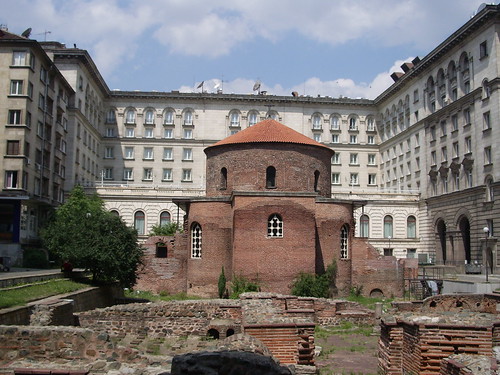Churches and a Communist Legacy

Early Church surrounded by Communist Buildings
We’ve been travelling around Bulgaria for a few days now. After Plovdiv, we headed for the smallish city of Samokov, which is very close to the Rila mountains. Our goal in heading there was to spend a bit of time outside and rest up a bit. We were very impressed with the city, which wasn’t very touristy at all, but still had english menus in the restaurants. Unfortunately there was limited hotel space and we could only stay 2 nights, before some outdoor group came that had everything booked up. So we spent our one full day there visiting the nearby ski resort of Borovetz, where we did some hiking. It was amazing the difference in price between Samokov and Borovetz, which are only about a 10 minute drive apart, as our lunch in Borovetz, which wasn’t very good, cost more than breakfast and dinner combined in Samokov. Samokov itself isn’t overly remarkable, except for the historical tidbit that it was the site of Bulgaria’s first commune, founded in 1909.
We decided that the easiest thing to do after Samokov was to come to the capital, Sofia, and use it as a base for visiting the Rila monastery, as well as taking a look around the city. Arriving here was a bit confusing. It turns out that there are two bus stations in the city, but all the directions we had was based on the assumption that we would arrive at the central station, which I guess is where most buses come in. Unfortunately, for some unknown reason, the bus we arrived on was one of the oddball ones that went to the south station, so the pickup we were expecting from our hostel didn’t arrive, and we were very disoriented when the taxi took us into the city, which wasn’t an overly fun experience, as we weren’t exactly confident the driver knew where he was going (or was taking us on the most direct route).
Despite being told by other travellers that Sofia isn’t much to see, we’ve actually been kind of impressed. I think the big reason is that our hostel offers a walking tour of the city, with a very knowledgeable guide, which makes all the difference between just seeing sites and understanding the history behind them. Much of what we saw on our tour was churches, as well as a mosque and a synagogue. Many Bulgarians are proud of their history, where when so many other Balkan states were suffering wars over ethnic and religious divisions, Bulgaria was stable and tolerant. Now, there has been recent growth of an ultra-nationalist party (Ataka, meaning, Attack), which seems bent on upsetting this tradition, and now represents about 9% of the electorate. They were outside the mosque, collecting signatures to try to force some sort of ban on the mosque sounding the call to prayer, something it already only does once a day.
I also learned a bit about the communist history here. Apparently, unlike Russia, religion wasn’t exactly banned, but the communist party definately discouraged it, but didn’t go so far as to destroy the buildings the way the Russians did. But being seen to be affiliated with the church or other religious organizations could result in losing your job, your children not getting a university education, and so forth. Later, when we visited a piece of the Berlin wall which has been moved here, our guide was telling us just how stupid the dictators could be, as the man who ruled for more than 30 years, from the ’60s up until 1989, hadn’t even finished high school, and when he would give speeches, not only was the large, childlike print on the pages in front of him visible, but he had a hard time reading them, once wishing everyone a happy and successful 1975 as part of his new year’s address for 1976.
So far, things have been interesting. We’re hoping to head to the Rila Monastery tomorrow.
– Neil
Tags: Bulgaria, Cairo to Budapest and Beyond

Leave a Reply